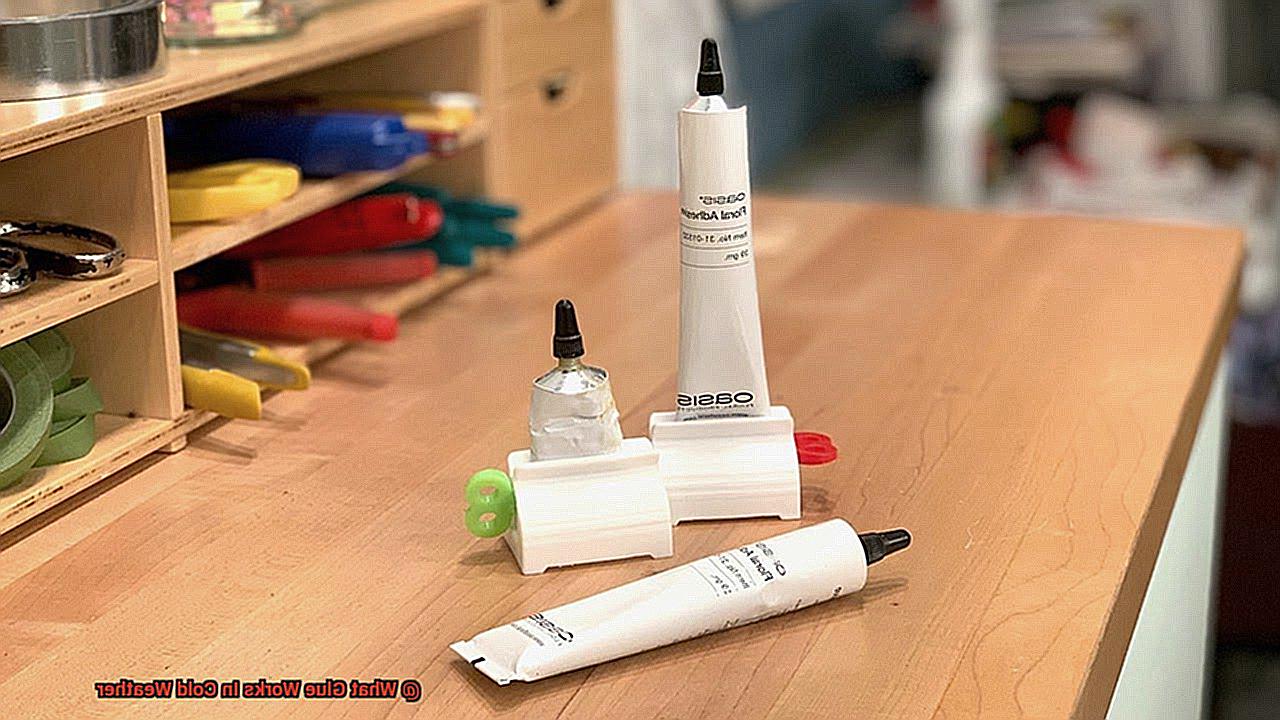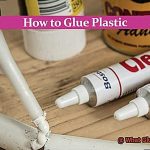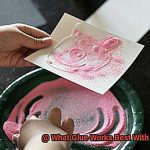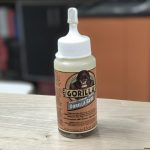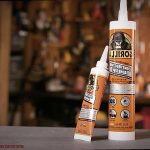Winter is a magical time, with snowflakes and cozy nights by the fire. But when it comes to sticking things together in the cold, things can get tricky.
Glue doesn’t always play nice when the temperature drops. But don’t worry.
In this blog post, we’re going to explore the world of adhesives and find out which ones actually work best in chilly weather. Whether you’re a DIY lover or a pro contractor, we’ve got your back with some fail-proof recommendations.
So, grab a mug of steaming hot cocoa and let’s dive into the world of gluing solutions for cold weather.
What is Glue and How Does it Work?
Contents
- 1 What is Glue and How Does it Work?
- 2 Challenges of Glue in Cold Weather
- 3 Epoxy Adhesive for Cold Weather
- 4 Polyurethane Adhesive for Cold Weather
- 5 Not All Glues Labeled “Cold Weather” Are Suitable for Extremely Low Temperatures
- 6 Storing Glue at Room Temperature Before Application
- 7 Applying Glue Above Freezing Point
- 8 Choosing the Right Glue for Your Materials
- 9 Conclusion
Glue is a captivating substance that possesses the power to join materials together, creating an unbreakable bond. But have you ever pondered over the secrets behind its magical abilities? In this article, we will delve into the enchanting world of glue, exploring its composition and the mechanisms it employs to create a formidable bond between surfaces. Moreover, we will tackle the challenges presented by cold weather conditions and highlight specialized glues designed to conquer these obstacles.
The Science Behind Glue:
Composed of polymers, solvents, and additives, glue is a captivating concoction. Polymers, which are long chains of molecules, provide glue with its adhesive properties. When applied to a surface, the solvent evaporates, leaving behind sticky polymer molecules that interact with the molecules on the surface.
Types of Bonds:
Glue forms bonds through physical or chemical interactions. Physical bonds occur when glue molecules entangle with surface molecules, creating mechanical bonds. Pressure-sensitive adhesives rely on physical bonds and require pressure for optimal bonding.
Chemical bonds occur when glue molecules chemically react with surface molecules, resulting in the formation of new compounds that bind the surfaces together. Epoxy adhesives exemplify glues that form chemical bonds through a curing process.
Conquering Cold Weather:
Cold weather poses challenges for glues as low temperatures affect their viscosity and drying time. However, some glues are specifically formulated to excel in cold weather conditions.
Epoxy adhesives exhibit excellent performance in cold temperatures. They remain flexible and maintain their adhesive strength even in freezing conditions, making them ideal for outdoor structures and repairs exposed to cold weather.
Polyurethane adhesives also thrive in cold weather. They showcase flexibility and resistance to extreme temperatures, making them suitable for various applications.
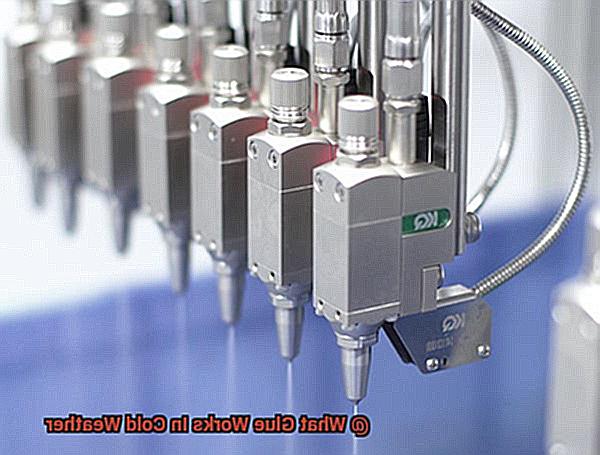
Tips for Success:
When using glue in cold weather, it is crucial to store the adhesive at room temperature before application. This allows the glue to reach its optimal viscosity and ensures proper bonding.
Applying glue when the temperature is above freezing point is vital. Cold surfaces hinder the adhesive’s curing process and compromise bond strength.
Consider the specific materials you plan to bond before embarking on a project in cold weather. Different glues work better with certain materials, so selecting a compatible glue is advisable.
Challenges of Glue in Cold Weather
Using glue in cold weather presents several challenges that can affect its performance and effectiveness. Glue is a crucial tool in various applications, from crafting to construction, but low temperatures can hinder its adhesive properties. Let’s explore these challenges and discover how to overcome them.
Firstly, one of the main obstacles is that many types of glue become less viscous or freeze altogether in cold temperatures. When glue freezes, it hardens and becomes brittle, losing its ability to adhere. This can result in the failure of bonded joints, causing objects to come apart or lose their structural integrity. No one wants their carefully crafted masterpiece to fall apart due to the cold.
Another challenge is the extended curing time in cold weather. Curing refers to the time it takes for the glue to fully dry and bond surfaces together. In low temperatures, the curing process significantly slows down, leading to project delays. Patience becomes a virtue when working in chilly conditions.
Additionally, some glues may not bond well in cold weather due to poor wetting or adhesion properties. Wetting refers to how well the glue spreads and adheres to the surfaces being bonded. In cold temperatures, surfaces may be colder and less receptive to bonding, resulting in weaker adhesive strength. It’s like trying to stick two ice cubes together – not an easy feat.
To tackle these challenges, it’s crucial to choose the right type of glue for cold weather conditions. Certain glues are specifically designed to perform better in lower temperatures and have a lower freezing point. These glues often contain additives or have different chemical compositions that allow them to remain flexible and adhesive in cold weather. Examples include certain epoxy adhesives, polyurethane glues, and cyanoacrylate (super glue). Before using any glue in cold weather conditions, always read the instructions and specifications provided by the manufacturer.
In extreme cold conditions, additional measures may be necessary. Pre-warming surfaces or using heat guns can aid in the bonding process, ensuring a strong and lasting bond. However, it’s important to exercise caution and follow safety guidelines when using heat sources.
Epoxy Adhesive for Cold Weather
Don’t let the frigid temperatures of winter put a freeze on your DIY projects. With the right adhesive, you can conquer any bonding challenge, even in the coldest of weather. And when it comes to adhesive superheroes, epoxy adhesive takes the crown. So, what are the advantages and disadvantages of using epoxy adhesives in cold weather? Let’s break it down:
Advantages:
- Excellent Cold Resistance: Epoxy adhesives are like the winter warriors of the adhesive world. Their chemical structure enables them to maintain their strength and bonding properties even in freezing temperatures. So, whether you’re working on a project in sub-zero weather or dealing with frosty surfaces, epoxy adhesive has your back.
- Wide Temperature Range: Epoxy adhesives are versatile and can be used in a wide range of temperatures, including as low as -20 degrees Celsius. This means you can confidently tackle your projects throughout the winter season without worrying about the adhesive losing its effectiveness.
- Speedy Curing Process: The curing process of epoxy adhesives is exothermic, which means it generates heat during the reaction. This is a game-changer in cold weather because it helps to speed up the curing process and ensures proper bond formation. No more waiting around for hours in freezing temperatures.
- Durability and Versatility: Epoxy adhesives offer excellent resistance to moisture, chemicals, and UV radiation, making them ideal for various outdoor applications in cold weather. Whether you’re fixing outdoor furniture or working on a craft project that will be exposed to the elements, epoxy adhesive will stand up to the challenge.
- Specialized Formulations: Some manufacturers offer specialized epoxy adhesives specifically designed for cold weather applications. These products may have enhanced cold resistance properties and shorter cure times in low temperatures. So, if you’re planning to embark on a winter project, consider using one of these specialized formulations for optimal results.
Disadvantages:
Extended Cure Time: It is important to note that the cure time of epoxy adhesives may be extended in cold weather compared to warmer temperatures. Therefore, it is recommended to follow the manufacturer’s instructions regarding cure times and allow sufficient time for full curing.
To ensure the best bond strength, proper surface preparation is key when using epoxy adhesive in cold weather. Make sure that the surfaces being bonded are clean, dry, and free from any contaminants.
Successful Uses:
Epoxy adhesives have proven their worth in cold weather environments through various successful applications. For example, in the construction industry, epoxy adhesives are commonly used to bond concrete in low-temperature conditions. In automotive repair, epoxy adhesives are utilized to repair cracked windshields during chilly winters. Additionally, epoxy adhesives have been successfully employed in outdoor woodworking projects, such as building and repairing wooden structures like fences and decks.
Polyurethane Adhesive for Cold Weather
Winter is a time when many DIY enthusiasts find themselves trapped indoors, unable to tackle their projects due to the challenges posed by cold weather. But fear not. With the mighty power of polyurethane adhesive, you can conquer any cold weather bonding challenge and ensure your projects withstand even the harshest winter conditions.
In this blog post, we will explore the advantages of using polyurethane adhesive for bonding materials in cold weather, so you can unleash your creativity and get your projects done, no matter how low the temperature drops.
Advantage 1: Excellent Low-Temperature Resistance
Polyurethane adhesive remains flexible and maintains its adhesive properties even in freezing temperatures. Unlike some adhesives that become brittle or lose their effectiveness in the cold, polyurethane adhesive stays strong and reliable. This flexibility allows it to accommodate thermal expansion and contraction due to temperature changes, ensuring a durable bond that can withstand extreme cold.
Advantage 2: Versatility
Whether you need to bond metal, wood, plastic, or even concrete, polyurethane adhesive is up for the task. Its versatility makes it an excellent choice for various applications such as construction, automotive repairs, and outdoor projects. No matter what materials you are working with, polyurethane adhesive will provide a strong and reliable bond.
Advantage 3: Water Resistance
In cold weather conditions where snow and moisture are present, water resistance is crucial. Polyurethane adhesive forms a waterproof seal that prevents water from seeping into the bonded area and compromising the bond strength. This feature is especially important for outdoor applications where exposure to snow or rain is likely.
Advantage 4: Low-Temperature Curing
Polyurethane adhesive cures effectively at lower temperatures, unlike some other adhesives that require warm temperatures to cure properly. This makes it convenient for use in colder climates or during winter months when other adhesives may not perform optimally. So, even in freezing temperatures, you can trust polyurethane adhesive to provide a reliable bond.
Not All Glues Labeled “Cold Weather” Are Suitable for Extremely Low Temperatures
When it comes to finding the perfect adhesive for extremely low temperatures, not all glues labeled as “cold weather” are created equal. It’s time to dig deeper and unravel the mysteries behind these chilly adhesives.
First and foremost, let’s debunk the myth that all cold weather glues are suitable for the most frigid conditions. The truth is, these glues vary in their effectiveness. Some may crumble under mildly cold temperatures, while others can brave the harshest freezes with ease. So, don’t be fooled by labels alone.
Next, let’s explore the fascinating world of formulation. Cold weather glues come in a variety of formulations, each with its own unique strengths and weaknesses. Some are specifically designed for outdoor use, enduring temperature fluctuations, moisture, and even UV exposure. These glues are perfect for repairing outdoor equipment or securing those festive decorations during the winter months. On the other hand, there are glues better suited for indoor applications, such as bonding materials in cold storage facilities or refrigeration units.
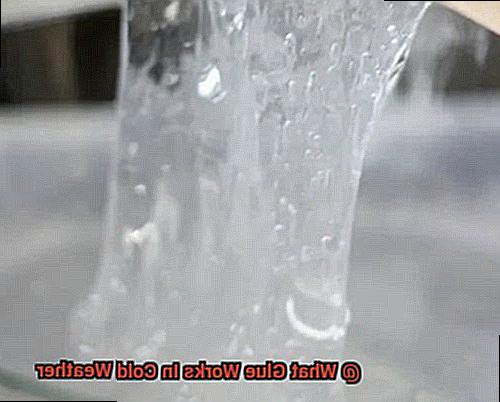
Temperature range is a crucial factor to consider when selecting a glue. Each glue has its optimum temperature range for peak performance. That’s why reading the product specifications and instructions is essential. By doing so, you’ll gain a clear understanding of whether a particular glue can handle your desired temperature range.
Lastly, remember to follow the instructions provided by glue manufacturers. These instructions offer valuable insights into achieving the best results in any temperature. From surface preparation to application techniques and curing times, following these guidelines will ensure your project stays intact no matter how cold it gets.
Storing Glue at Room Temperature Before Application
In the world of DIY and crafting, glue is a powerful tool that holds everything together. But did you know that temperature can impact its performance? Storing glue at room temperature before application is crucial for achieving optimal results. Let’s dive into why this is so important.
Glue, like any sensitive creature, doesn’t appreciate extreme temperatures. It has specific storage requirements, and straying from those guidelines can spell disaster for your projects. Reduced bonding strength or complete failure? No thank you.
So, what exactly is room temperature? It refers to a cozy range between 68°F (20°C) and 72°F (22°C). Steer clear of scorching hot or freezing cold conditions because extreme temperatures can wreak havoc on glue’s chemical composition and adhesive properties. We certainly don’t want that.
When glue encounters low temperatures, it becomes thick and gooey, making it a nightmare to apply. And the curing process? It slows down significantly, resulting in longer drying times. On the flip side, high temperatures turn glue into a watery mess that refuses to stick properly. Talk about a sticky situation.
To keep your glue happy and ready for action, store it in a climate-controlled environment. Avoid exposing it to drastic temperature changes near windows or heating vents. And don’t forget to tightly seal those containers when not in use. Moisture is not its friend.
Now, certain glues have specific storage requirements. Take epoxy adhesives, for example. These babies might need a cool environment or even a spot in the fridge to maintain their peak performance. Always read and follow the manufacturer’s instructions for optimal storage conditions. Safety first.
And here’s a pro tip: if your glue has been exposed to extreme temperatures or stored improperly, say goodbye and grab a fresh bottle. Compromised glue leads to weak bonds, and nobody wants their hard work falling apart.
Applying Glue Above Freezing Point
Glue is the unsung hero of our projects, quietly holding everything together. But what happens when our trusty adhesive faces freezing temperatures? Fear not, for I am here to share expert advice on how to apply glue above the freezing point with success. So grab a warm beverage and let’s dive into the world of cold weather gluing.
Specialized Adhesives for Cold Weather:
Not all glues are created equal in chilly conditions. Fortunately, there are specialized glues designed to tackle the cold head-on. Two mighty options are cold-weather epoxy and polyurethane adhesive. Cold-weather epoxy boasts the ability to cure and bond effectively at temperatures as low as -20°F (-29°C). Meanwhile, polyurethane adhesives flaunt flexibility and durability, enduring temperatures as low as -40°F (-40°C). These glues are your secret weapons against winter’s icy grip.
Storage and Surface Preparation:
Just as we seek warmth in winter, glue needs to be stored at the recommended temperature before use. This ensures optimal performance when you need it most. Moreover, warming up the surface where the glue will be applied promotes superior adhesion. You can use a heat gun or simply allow the object to bask in a warmer environment. Imagine giving your project a warm hug before bonding.
Extended Curing Time:
Patience is key when working with glue in cold weather. Lower temperatures slow down the curing process, so it’s essential to give your adhesive enough time to fully bond. Be prepared to extend the curing time beyond what’s recommended by the manufacturer, especially if it’s frigid outside. Remember, good things come to those who wait.
Alternative Bonding Methods:
Sometimes, even specialized cold-weather glues may struggle in extremely low temperatures. Fear not, my cold-weather warriors, for there are alternative bonding methods to explore. Mechanical fasteners can come to the rescue, providing a sturdy hold in freezing conditions. Additionally, adhesive experts can offer tailored guidance for your specific cold weather scenario. Don’t let the cold freeze your creativity.
Choosing the Right Glue for Your Materials
When it comes to cold weather projects, selecting the right glue is crucial for ensuring a strong and durable bond that can withstand the challenges of low temperatures. Here are some factors to consider when choosing the perfect glue for your materials in cold weather conditions.
One type of glue that works well in cold weather is cyanoacrylate glue, commonly known as super glue. This glue is known for its quick drying time and strong bond on various materials like metal, plastic, and wood. However, it may become brittle in extremely low temperatures, so it’s more suitable for indoor use or mild cold weather conditions.
Another suitable option for cold weather is epoxy adhesive. This two-component glue consists of a resin and a hardener. It forms a strong and durable bond even in cold temperatures. Perfect for outdoor applications or materials exposed to extreme cold, epoxy works well on ceramics, glass, and metals.
Silicone adhesive is another option to consider when working in cold weather. It remains flexible and maintains its bond strength in low temperatures. Silicone adhesive is commonly used for sealing and bonding applications, especially in areas with temperature fluctuations. It can be used on plastics, glass, rubber, and more.
Always read product labels and instructions carefully when selecting glue for cold weather use. Look for glues that specifically mention suitability for low temperatures or extreme weather conditions. Consider factors like drying time, flexibility, and the specific materials you’ll be working with.
In some cases, using a combination of different adhesives may be necessary to achieve the desired bond strength in cold weather conditions. For example, a combination of epoxy adhesive and silicone adhesive can provide both strength and flexibility for certain applications.
Proper surface preparation is essential for achieving a strong bond in cold weather. Ensure that the surfaces to be bonded are clean, dry, and free from any contaminants or debris. Roughening the surface slightly with sandpaper can also improve the adhesive’s grip.
_0bduKNF7CQ” >
Also Read: Glue Types
Conclusion
When it comes to finding a glue that can withstand the frigid temperatures of winter, you need a solution that won’t freeze up on you.
Luckily, there are several options available that are specifically designed to work in cold weather conditions. One such glue is cyanoacrylate, commonly known as super glue.
This adhesive has a quick-drying formula that bonds almost instantly and remains strong even in low temperatures. Another option is epoxy resin, which provides a durable and resilient bond that can withstand freezing temperatures without losing its effectiveness.
For outdoor applications, polyurethane-based adhesives are an excellent choice. These glues offer exceptional resistance to cold weather and can be used on various materials like wood, metal, and plastic.
So whether you’re repairing a broken outdoor ornament or working on a DIY project during the chilly winter months, there’s a glue out there that will keep everything together even when the temperature drops.

